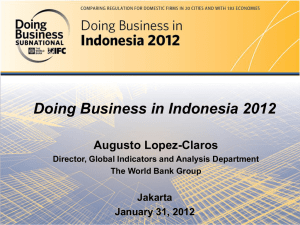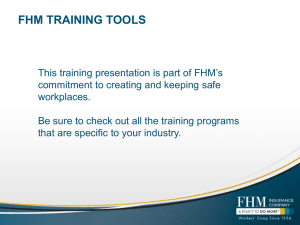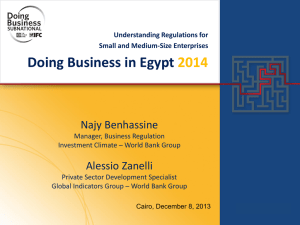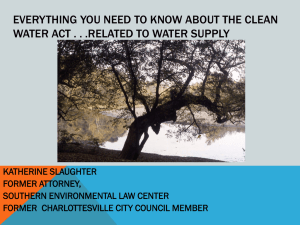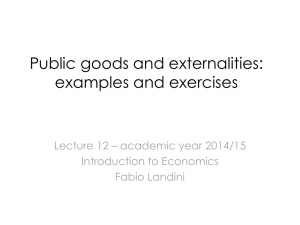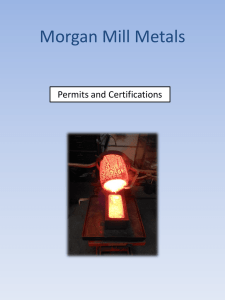Incentive-Based Strategies: Transferable Discharge Permits
advertisement
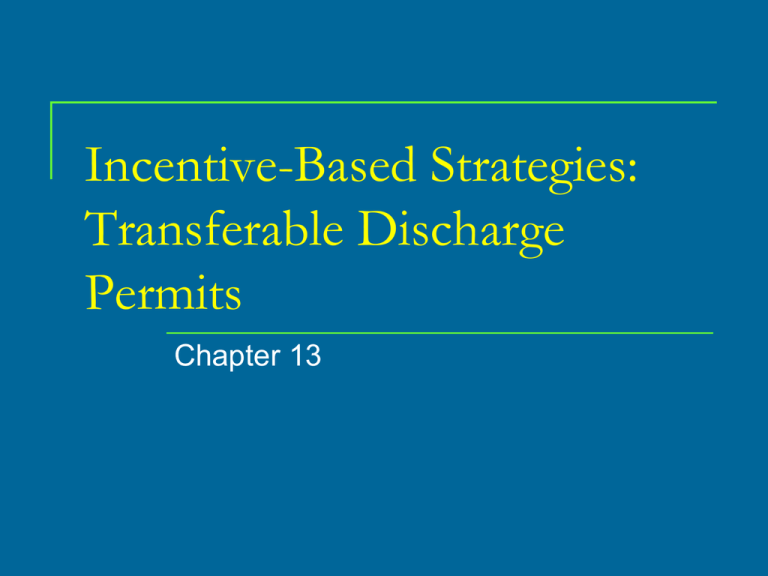
Incentive-Based Strategies: Transferable Discharge Permits Chapter 13 Transferable Discharge Permit In a transferable discharge permit (TDP) system, a new type of property right is created. This property right consists of a permit to emit pollutants. Each permit entitles its holder to emit one unit (pound, ton, etc.) of the waste material specified in the right. Rights holders would ordinarily have a number of such permits at any point in time. If a discharger owned 100 permits, it would be entitled to emit a maximum of 100 units of effluent per time period. 2 Limiting the Permits A CAP (TDP) program begins by a centralized decision on the total number of discharge permits to be put into circulation. These permits are then distributed among the sources responsible for the emissions. Assuming that the total number of permits is less than current total emissions, some or all emitters will receive fewer permits than their current emissions. 3 Options Consider a power plant that is emitting 7,000 tons of sulfur currently. This plant is initially given 5,000 discharge permits. The plant manager now has three choices. 1) Reduce the emissions to 5,000 tons 2) Buy additional permits and emit more than 5,000 tons. 3) Reduce emissions below 5,000 tons, then sell the permits it doesn't need. 4 Buying and Selling Permits Consider Figure 13.1 Assume A gets 60 permits and B gets 45 permits in the original distribution. A would be willing to sell a permit for anything above $1,200 and B would be willing to buy a permit for anything below $4,000. Gains from trade would continue to exist and permits would continue to be traded until marginal abatement costs are equalized. 5 6 Trading Satisfies the Equimarginal Principle This occurs at emission levels of 40 tons for A and 65 tons for B. Source A has reduced its holdings of discharge permits to 40 (the 60 permits it was initially awarded minus the 20 sold to B). B has increased its holdings to 65 permits (45 plus the 20 bought from A). Note, however, that as long as the total number of permits in circulation is constant, total emissions will be constant. 7 Single Market for Permits In order for the equimarginal principle to be satisfied in this case, it is necessary that all permit buyers and sellers be trading permits at the same price. What this requires is a single overall market for permits where suppliers and demanders may interact openly and where knowledge of transactions prices is publicly available to all participants. The normal forces of competition would then bring about a single price for permits. 8 Many Traders The demanders would be new firms that wish to begin operations in the trading area or existing sources expanding their operations. Suppliers of permits would include firms leaving the area or going out of business, or firms that have invested in better abatement techniques and now have excess permits to sell. In any particular year there would be a tendency for a market price to establish itself, such as p* in Figure 13-2, and for a certain number of permits to change hands, such as q* in the figure. 9 10 11 Property Rights The idea of transferable discharge permits has become more popular among some environmental policy advocates, as well as among policymakers. CAP programs begin by creating and distributing a new type of property right. From a political standpoint, it is perhaps easier for people to agree on a pollution-control policy that begins by distributing valuable new property rights than by notifying people they will be subject to a new tax. 12 The Initial Rights Allocation Individual polluters will want as many permits as they can get in the first distribution The original distribution of emission rights is a tough issue. distributed equally to existing sources distributed in accordance with existing emissions auctioned to highest bidder 13 Does it Matter? In principle it doesn't matter if permits get distributed fairly widely. Subsequent market transactions will redistribute them in accordance with the relative marginal abatement costs of polluters whatever the original distribution may have been. An auction would transfer income to the government agency. 14 Establishing Trading Rules In order to reduce transactions costs, the public agency should set simple and clear rules and then allow trading to proceed. Whether national environmental groups should be able to buy permits on a regional market is problematic because the amount they were willing to pay for permits might have no close relationship to underlying true social willingness to pay. 15 Reducing the Number of Permits How does the total number of permits get reduced over time? Improving ambient quality means reducing the overall number of permits in circulation Public agencies could buy back permits and retire them. Allow organizations or individuals, particularly those from the environmental community, to purchase permits. 16 Reducing Permits Have each permit apply to emissions during a particular time period, say a given year. Then individual sources could be awarded a declining sequence of permits, each applicable to a particular future year. Instead of a source holding 100 permits for all future years, they might be given 100 permits for year 1, 95 permits for year 2, 90 for year 3, and so on. 17 Nonuniform Emissions Suppose emission sources are scattered in the surrounding region. They are not all equal in terms of marginal abatement costs, but neither are they equal in terms of the impact of their emissions on ambient SO2 levels over the populated area. In technical terms, they have different transfer coefficients linking their own emissions with damages in the urban area. 18 A Solution to Nonuniform Emmissions? Some people feel that the SO2 trading program established pursuant to the 1990 Clean Air Act has led to a concentration of permits in the hands of midwestern power plants, with negative impacts on cities of the northeast. If emissions from B were twice as damaging as the emissions of A because of the location of the two sources, administrators can set a rule that if B is buying permits from A, it must buy two permits to get one. 19 20 Zone Trading 1) Allow trading by firms only with other firms in the same zone. 2) make adjustments for all trades across zone boundaries similar to the technique discussed above. If sources in Zone B were judged to have transfer coefficients twice the size, on average, as sources in Zone A, then any firm in Zone B buying permits from any firm in Zone A would have to buy two permits in order to get credit for one new one. 21 CAPs and Problems of Competition From the standpoint of fostering competition, it would be best to establish trading zones with large numbers of potential buyers and sellers. There may be meteorological or hydrological reasons for limiting the trading area to a relatively narrow geographical area. If the objective was to control airborne emissions affecting a particular city, it would be better to prevent firms located there to buy permits from firms in another city. 22 CAP Programs and Enforcement An administering agency must keep track of two things: 1) 2) the number of permits in the possession of each source and the quantity of emissions from each source. An administrative agency must be able to monitor polluters to see whether emissions at each source exceed the number of permits it holds. 23 Monitoring by Other Sources One desirable feature of CAP programs is that sources may monitor each other. When sources emit more than they have permits for, they are essentially cheating by not buying sufficient permits. This reduces the demand for permits below what it would otherwise be. And this has the effect of lowering the market price of permits, which works against the interest of any firm holding large numbers of permits. 24 CAPs and the Incentive for R&D One of our main criteria for judging an environmental policy is whether or not it creates strong incentives for firms to seek better ways of reducing emissions. Emission standards were weak in this regard, whereas emission charges were much stronger. CAP programs in this respect are identical to emissions charges. 25 26 Summary • • The Clean Air Act Amendments of 1990 contain a CAP program for SO2 reduction among electric power producers. A new trading plan for NOX among eastern states. CAP programs have most recently been proposed for control of global CO2 reduction. This approach provides pollution control at a substantially lower cost than the current system of technology-based effluent standards. 27 Summary (cont’d) Both transferable discharge systems and emission charge systems seek to take the burden and responsibility of making technical pollution-control decisions out of the hands of central administrators and put them into the hands of polluters themselves. They do not put pollution-control objectives into the hands of the polluters. They provide incentives for polluters to find more effective ways of reducing emissions. 28 29


